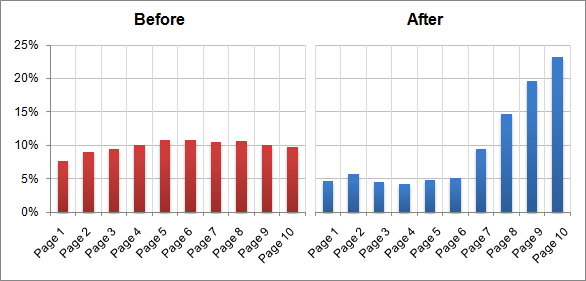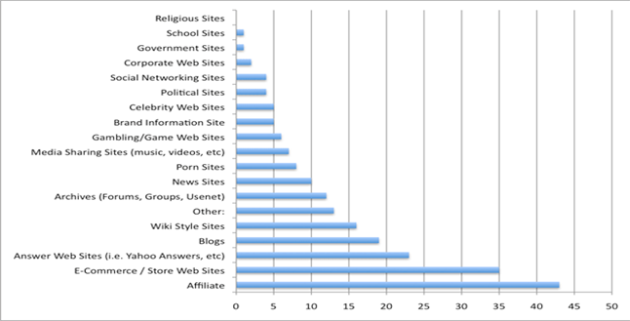This last year Google brought a large number of algorithm changes to the table. Although these changes helped increase traffic and rankings to many large corporations such as YouTube and eBay, it hurt a large majority of small businesses. According to Search Engine Land, some domains saw a 94% loss in visibility, and others were left picking up the pieces after they lost 80% of their keyword positions. Consider this graph by Sistrix, created to describe where mahalo.com’s keywords landed on Google search engine results pages (SERPs) before and after one of the Google algorithm updates:

Although there were several Google algorithm changes (some with more impact than others), all of them left businesses scratching their heads. One minute their tactics were working; the next minute they must change their approach entirely. If you found your business scrambling to stay afloat during these changes, you may not realize just how much treading you had to do to stay alive. In case you missed it through all the chaos, below lists all of the crazy Google changes that occurred in 2011and just what they all meant:
Top 10 Google Algorithm Changes of 2011
- Jan. 28: Attribution Update – Designed to help reduce spam levels on SERPs. This specifically targeted sites with unoriginal content; a way to make sure these pages are not ranked higher than where the content was originally published.
- Feb. 23: First Panda Update (Farmer Update) – Aimed at finding sites that write irrelevant content and then optimize it for rankings; often referred to as “content farms.” The launch initially impacted 12% of U.S. queries according to Search Engine Land.
- April 11: Panda update 2.0 – This incorporated Google searcher blocking data. If a user blocked a site during a search, Google would then take this into consideration when determining the worth of a website.
- May 9: Panda Update 2.1 – This update was very minor and many people did not notice a change. For this reason, the exact changes that occurred during the update were not discussed by Google.
 June 21: Panda update 2.2 – Once again, Google focuses on what experts now call “scraper detection.” The update focuses on content that is duplicated without your permission, or scraped (diversion and then republishing).
June 21: Panda update 2.2 – Once again, Google focuses on what experts now call “scraper detection.” The update focuses on content that is duplicated without your permission, or scraped (diversion and then republishing).- July 22: Panda update 2.3 – This was another minor update that was pushed out manually. Google claims the update “incorporates new signals.” Quality score is determined now by a blend of unique content and link score for that content.
- Aug. 12: Panda update 2.4 – This update stated that all algorithmic search improvements will be rolled out to other languages. According to Google, the change impacted 6-9% of queries. Oddly enough, Chinese, Japanese, and Korean languages were omitted.
- Sep. 28: Panda update 2.5 – This was supposed to be a minor update according to Google. However, many small businesses lost visibility and traffic while many larger businesses, such as FoxNews.com, benefitted from the change. This caused an uproar from small businesses who saw it as a way to keep the “big names” on top.
- Nov. 18: Panda Update 3.1 – This update was named “3.1” because many felt that some of the minor updates after 2.5 (labeled 2.51, 2.5.2, and 2.5.3) should have been labeled “3.0.” This update was considered a minor algorithm date refresh and didn’t get much attention.
- Dec. 1: Ten More Updates Announced – Although the updates are over for 2011, ten more updates were announced for 2012. This will affect businesses in the coming weeks, so many spend their time now, in 2011, trying to get ready. The new updates are said to focus on keyword density, keyword relevancy, and broken links.
What the Updates Mean for Your Company
Each Panda update meant something different for each company. While some were hit hard by 2.5, others remained stable until 3.1 hit. However, it is safe to say that the majority of small businesses were affected by at least one of the Panda updates in 2011. The graph below was taken from Search Engine Roundtable and illustrates the types of sites that were hit hardest by Panda 2.5:

Unfortunately, many small businesses are still trying to recover from all of the updates. According to Search Engine Roundtable, over 70% of those who took their online poll reported that they have still not recovered. Nonetheless, 2012 is the time to take these Panda updates seriously and make SEO changes for the better. Consider a few of the ways your company can follow the new Panda guidelines:
- Create new and original content
- Promoting that content through social media
- Make sure that all links are relevant.
- Google also introduced the “+1” option for individuals and businesses to utilize. This overlaps with utilizing social media; it will help show Google that your site is popular.
- Do not duplicate/copy another site’s content. While this might be okay every once and a while with the sites permission, do not make it a habit.
- Don’t bite off more than you can chew. In other words, if you don’t have the funds or the staff to create new content for three domains, consider selling one. It is extremely important to listen to these Google Panda updates and try and abide by their standards.
Although it may take a while to get your sight back to where you want it on those Google SERPs, it will be worth it in the end. After all, Google makes these algorithm changes in order to give users the best possible experience while online. Your site should have unique content and it should have relevant links. There is no reason that only the well-known websites should make it to the top of Google. If you follow the rules and optimize your website correctly, you have just as much a chance to be seen as any other business.
Amanda DiSilvestro is a writer on topics ranging from social media to merchant services. She writes for an online resource that gives advice on topics including phone systems to small businesses and entrepreneurs for Resource Nation.




Now it is more important than ever to really push the limits of social media in order to gain important search visibilty.
Definitely. And I have to say, I’m loving Google+. If anyone is still nervous about it or keeping it on the back burner, I’d put some effort into it. It’s great!
I think this furthers proves that businesses need to spend the majority of their time and money making sure their sites are optimized for the user experience in terms of what they find and how they find it. Good content updated often that is original and useful is nothing new. If you focus the majority of your efforts on “gaming the system”, eventually you will lose! Great post Tamar, this really sums this all up nicely!
Don’t thank me, thank Amanda 🙂
I think you absolutely hit the nail on the head when you say good content updated often that is original is nothing new. Companies should be focusing on users, and what user doesn’t want to see unique content? It’s all about what’s best for the user, not what Google wants (although they generally coincide). Thanks so much for reading!
It’s true, you can never get too complacent about anything. There will always be changes, in all spheres of life, and people will adapt.